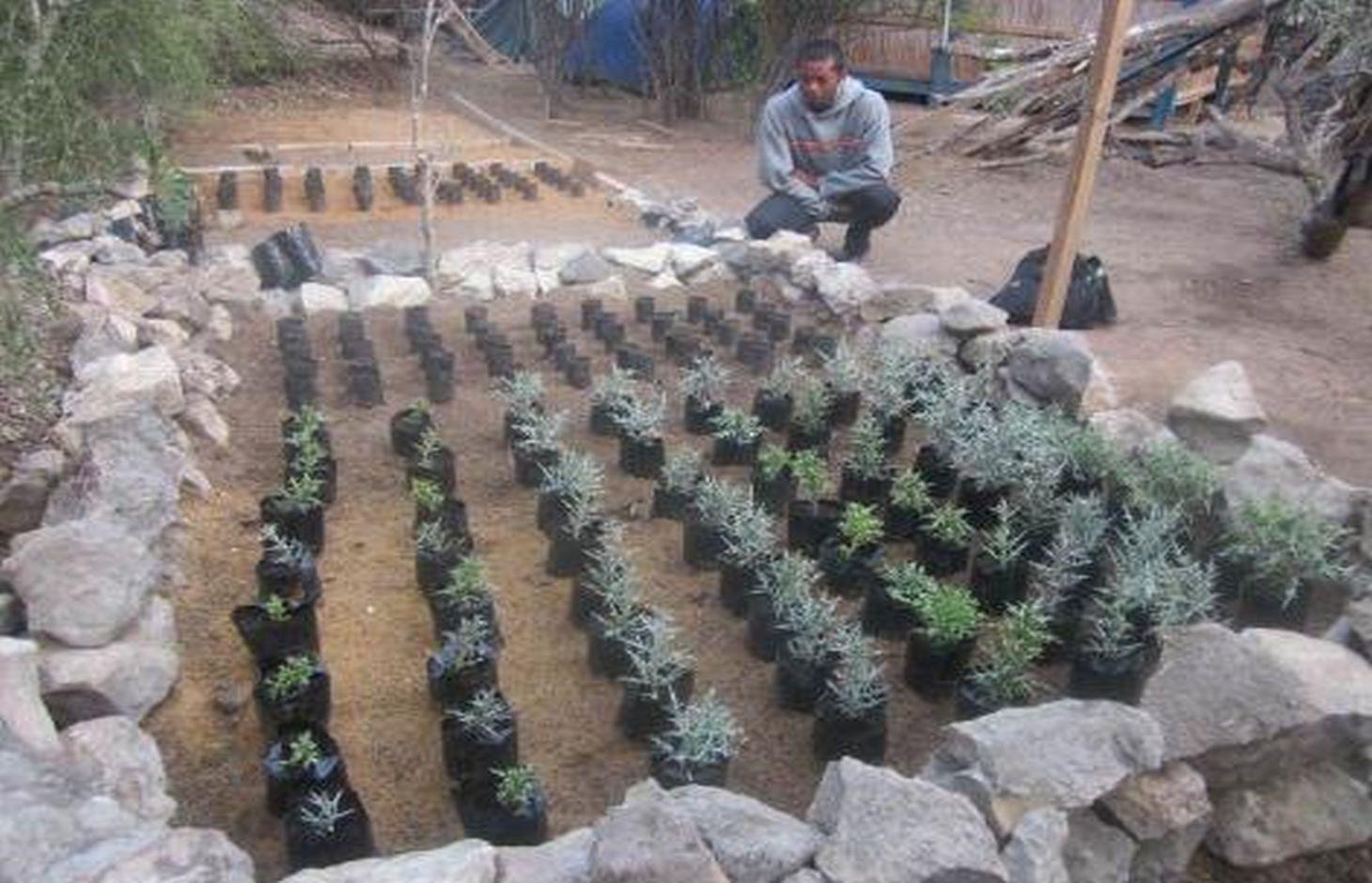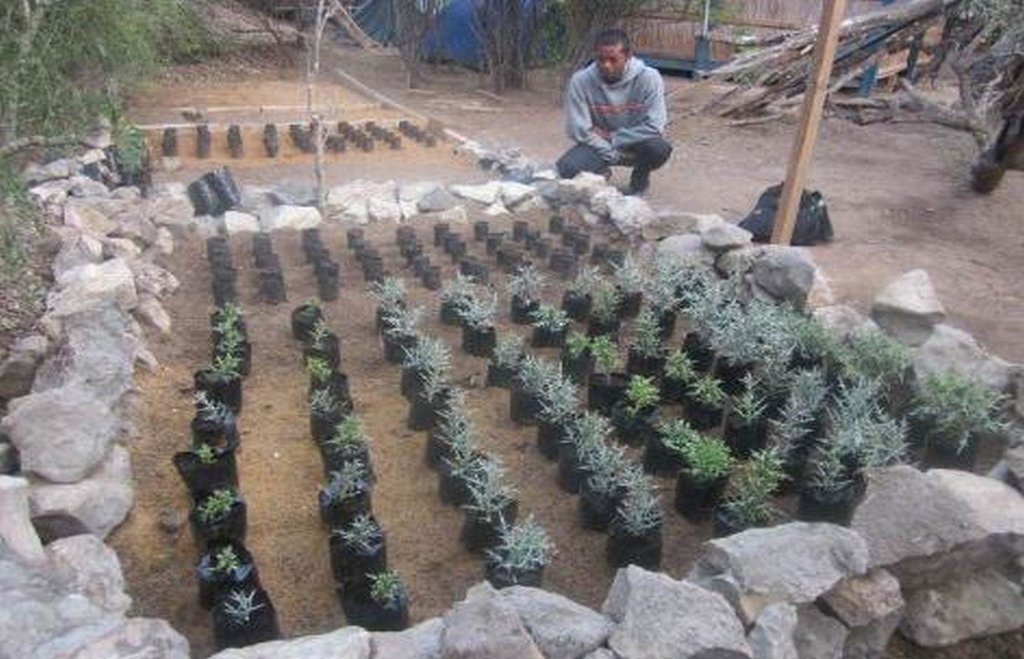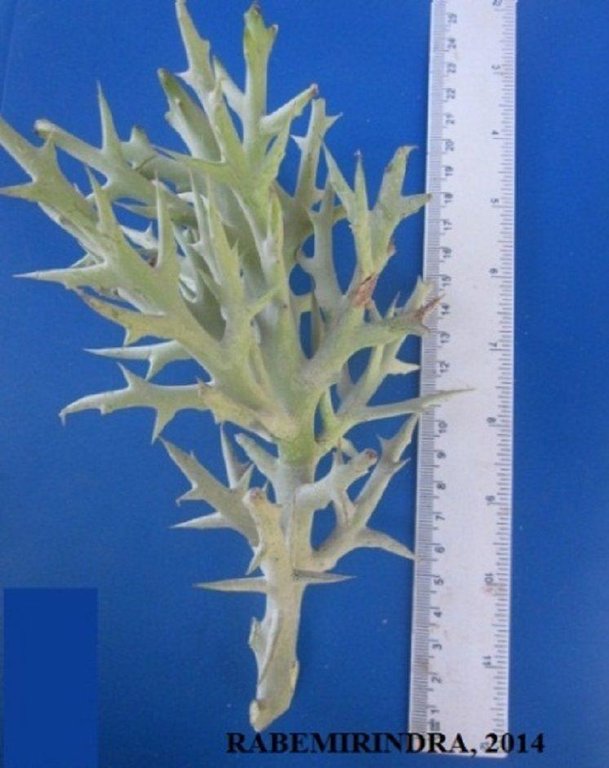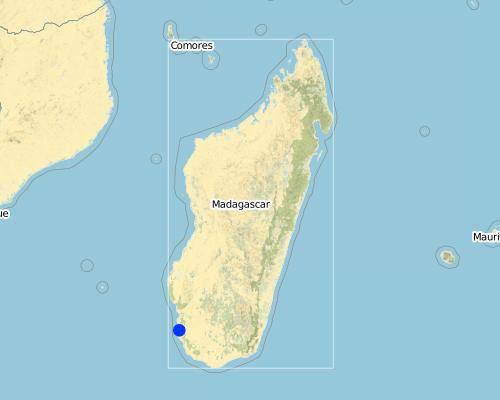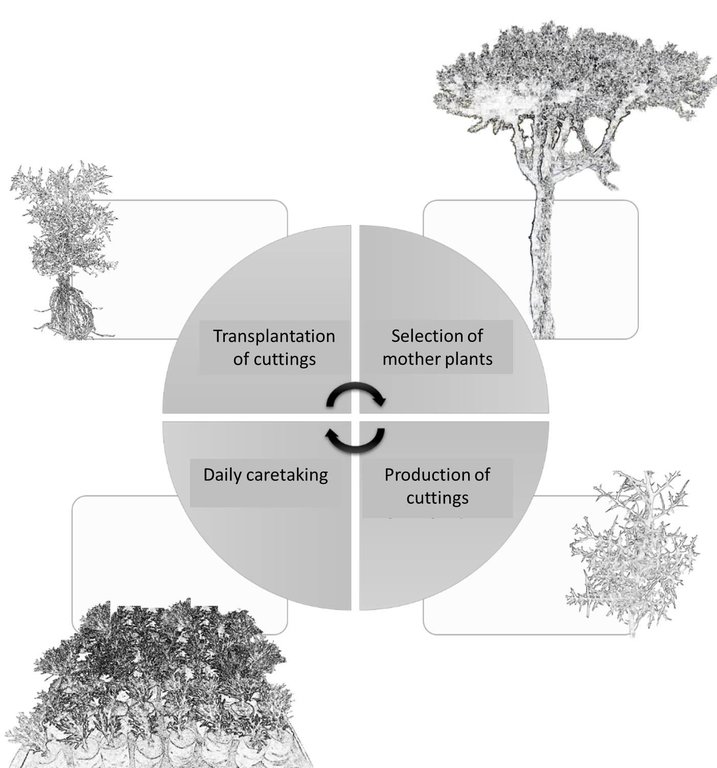Sustainable propagation of the fodder tree Euphorbia stenoclada (“samata”) [Мадагаскар]
- Шинийг нээх:
- Шинэчлэх:
- Эмхэтгэгч: Johanna Goetter
- Хянан тохиолдуулагч: –
- Хянагчид: David Streiff, Fabian Ottiger
technologies_1677 - Мадагаскар
- Бүрэн хураангуйн PDF хувилбар
- Бүрэн хураангуйг PDF-ээр хэвлэх
- Хөтөч дэх бүрэн хураангуй
- Бүрэн хураангуй (форматгүй)
- Sustainable propagation of the fodder tree Euphorbia stenoclada (“samata”): 09 3-р сар 2017 (inactive)
- Sustainable propagation of the fodder tree Euphorbia stenoclada (“samata”): 03 5-р сар 2017 (inactive)
- Sustainable propagation of the fodder tree Euphorbia stenoclada (“samata”): 03 5-р сар 2017 (inactive)
- Sustainable propagation of the fodder tree Euphorbia stenoclada (“samata”): 05 9-р сар 2019 (public)
Бүлгүүдийг үзэх
Бүгдийг дэлгэх Бүгдийг хаах1. Ерөнхий мэдээлэл
1.2 Технологийг үнэлэх, баримтжуулах ажилд хамаарах мэдээлэл өгсөн хүмүүс, байгууллагуудын холбоо барих мэдээлэл
ГТМ мэргэжилтэн:
Herinavalona Rabemirinra
University of Antananarivo
Présidence de l'Université d'Antananarivo: BP 566, Antananarivo 101, Madagascar
Мадагаскар
ГТМ мэргэжилтэн:
Yeddiya Ratovonamana
World Wildlife Fund (WWF Toliara)
Мадагаскар
ГТМ мэргэжилтэн:
Goum O. Antsonantenainarivony
University of Antananarivo
Мадагаскар
Технологи баримтжуулах/үнэлэх ажилд дэмжлэг үзүүлсэн төслийн нэр (шаардлагатай бол)
Book project: Making sense of research for sustainable land management (GLUES)Технологи баримтжуулах/үнэлэх ажилд дэмжлэг үзүүлсэн төслийн нэр (шаардлагатай бол)
Sustainable Landmanagement in south-western Madagascar (SuLaMa / GLUES)Технологи баримтжуулах/үнэлэх ажилд дэмжлэг үзүүлсэн байгууллага(ууд)-ын нэр (шаардлагатай бол)
Brandenburg Technical University (btu) - ГерманТехнологи баримтжуулах/үнэлэх ажилд дэмжлэг үзүүлсэн байгууллага(ууд)-ын нэр (шаардлагатай бол)
University of Antananarivo - МадагаскарТехнологи баримтжуулах/үнэлэх ажилд дэмжлэг үзүүлсэн байгууллага(ууд)-ын нэр (шаардлагатай бол)
World Wide Fund for Nature (WWF) - Швейцар1.3 ВОКАТ-аар баримтжуулсан өгөгдлийг ашиглахтай холбоотой нөхцөл
Мэдээллийг хэзээ (газар дээр нь) цуглуулсан бэ?
19/05/2015
Эмхэтгэгч болон гол мэдээлэгч хүн(хүмүүс) WOCAT аргачлалаар баримтжуулсан мэдээллийг ашиглахтай холбоотой нөхцлийг хүлээн зөвшөөрсөн:
Тийм
1.5 ГТМ-ийн Арга барилын талаархи санал асуулгын(д) суурь мэдээлэл
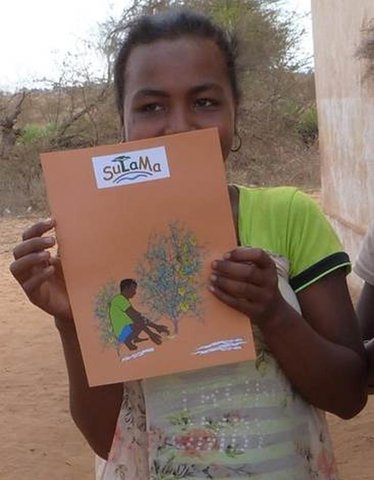
Increasing environmental awareness using comic-style illustrations as a … [Мадагаскар]
Communicating and transferring scientific results and recommendations about sustainable land management to local people
- Эмхэтгэгч: Tobias Feldt
2. ГТМ Технологийн тодорхойлолт
2.1 Технологийн товч тодорхойлолт
Технологийн тодорхойлолт:
Propagation of “samata” cuttings for long-term provision of supplementary livestock fodder to reduce the pressure on natural vegetation.
2.2 Технологийн дэлгэрэнгүй тодорхойлолт
Тодорхойлолт:
The succulent evergreen tree Euphorbia stenoclada (“samata”) is the most important dry season fodder resource on the coastal plains grazing grounds in the Mahafaly Plateau region. To increase production, samata can be vegetatively propagated with cuttings raised in a nursery. The advantages are: (a) protection against livestock, (b) selection of the most appropriate planting stock to propagate and (c) easy watering. Cuttings should only be taken from mature trees 7-10 years old and 3-4 m high. The mother plants should be healthy, with few spines, and no previous cuttings taken. Cuttings are taken at the upper nodes of the branches, approximately 20-25 cm long and 0.5-1.5 cm diameter. Transport of the cuttings to the nursery should be carried out in the morning to avoid heat. For effective rooting, the cutting is planted 5 cm (1-2 nodes) into a humid substrate in a plastic pot or directly into the ground. Best results are achieved using white sea sand mixed with some organic material. Cuttings should be raised in a sunny location. During the first 15 days, the cuttings need to be watered once every morning. For the next 3-4 months, they need watering every second morning. 24 hours before transplantation from the nursery to the final destination, the cuttings should be abundantly watered. Rooted cuttings are transplanted into pits of 10 cm diameter and 15 cm depth, filled with the same substrate as used in the nursery. For 15 days, the transplants are watered on a daily basis, and afterwards every second day. After 30-45 days, the transplants are ready to survive without further care. If the planting location is open to roaming livestock, the cuttings need protection.
Purpose of the Technology: The samata tree naturally reproduces by seeds as well as by vegetative reproduction. However the German funded SULAMA research project has had most success with multiplication of the local variety with cuttings. This form of propagation is preferable as it is much faster and gives higher survival rates of the individuals: neither does it need much planting material, equipment or technical knowledge. Providing the villagers with the know-how, and assisting them to create local samata-nurseries, makes this technology promising. SuLaMa-WWF started this technique in April 2015, establishing 5 nurseries with 2,000 trees each (3 with village communities, 2 with local schools).
Establishment / maintenance activities and inputs: On the coastal plain of the Mahafaly plateau region, the climatic and edaphic conditions do not support livestock raising based mainly on grasses. For 6-7 months, the herders are dependent on supplementary fodder plants, especially samata. The tree is fed by cutting its branches and slicing them. However pressure on this resource has led to depletion of stocks around many villages: this results from increasing demand and reduced supply. Higher demand is the result of changed herd movements, especially a shorter transhumance period. Lower supply is attributed to decreased precipitation, overuse of trees leading to poor regeneration or even the death of trees, and reduced samata areas due to the expansion of private crop fields. The overuse of trees is triggered by the overall scarcity of this resource as well as an ongoing privatization of the historically common land resources.
2.3 Технологийн гэрэл зураг
2.5 Энэ үнэлгээнд хамрагдсан технологийг хэрэгжүүлсэн улс орон/ бүс нутаг/ байршил
Улс:
Мадагаскар
Улс/аймаг/сум:
Atsimo-Andrefana, Toliara
Байршлын дэлгэрэнгүй тодорхойлолт:
Toliara II, Beheloka
Тайлбар:
Application ongoing, the envisaged implementation area might be up to 1,000 km².
Map
×2.6 Хэрэгжсэн хугацаа
Байгуулсан тодорхой оныг мэдэхгүй бол баримжаа хугацааг тодорхойл:
- <10 жилийн өмнө (саяхны)
2.7 Технологийн танилцуулга
Технологийг хэрхэн нэвтрүүлснийг тодорхойл:
- Туршилт/судалгааны үр дүн
- Гадны төсөл/хөтөлбөрийн дэмжлэгтэйгээр
Тайлбар (төслийн төрөл г.м.):
Project started with experimental trials of multiplication by cuttings in February 2014, first capacity development for land users through workshops on propagation technique in May 2015.
3. ГТМ технологийн ангилал
3.2 Технологи нэвтрүүлсэн газрын одоогийн газар ашиглалтын хэлбэр(үүд)

Тариалангийн талбай
- Нэг наст үр тариа
Гол нэрийн үр тариа (арилжааны болон хүнсний таримал):
Major cash crop annual cropping: Maize
Major food crop annual cropping: Cassava
Other crops annual cropping: Sweet potato
Major cash crop tree/shrub cropping: Samata
Other crops tree/shrub cropping: Cactus

Бэлчээрийн газар
Бэлчээрийн мал аж ахуйн газар:
- Хагас нүүдлийн/ бэлчээрийн мал аж ахуй
Эрчимжсэн мал аж ахуй / тэжээл үйлдвэрлэл:
- Хадлан буюу бэлчээрт ашиглагдахгүй талбай
Тайлбар:
Major land use problems (compiler’s opinion): : Climatic constraints (especially low and erratic precipitation), deforestation, forest degradation, soil degradation, overgrazing, loss of arable land, fragmentation, low availability of surface and (very saline) ground water, privatization of common pool resources.
Major land use problems (land users’ perception): Climatic constraints, loss of arable land, low availability of animal fodder, soil degradation, low availability of surface and (very saline) ground water.
Semi-nomadism / pastoralism: Yes
Cut-and-carry/ zero grazing: Yes
Type of cropping system and major crops comments: samata trees are both found on the grazing area (naturally), as well as on agricultural fields (naturally, transplanted). Main reason for transplanting to fields however not shade/other positive interaction with crops, but for property rights reasons.
3.3 Газар ашиглалтын тухай нэмэлт мэдээлэл
Технологи хэрэгжүүлсэн газрын усан хангамж:
- Байгалийн усалгаатай
Жилд ургамал ургах улирлын тоо:
- 1
Тодорхойлно уу:
Longest growing period from month to month: June - September
Малын нягт (шаардлагатай бол):
1-10 LU /km2
3.4 Технологи ГТМ-ийн аль бүлэгт хамаарах вэ
- ургамлын сорт / малын үүлдэр сайжирсан
- Propagation of fodder plants
3.5 Технологийн хамрах талбай
Технологи өргөн дэлгэрсэн эсхийг тодорхойл:
- газар дээр жигд тархсан
Технологи газар нутгийн хэмжээнд жигд тархсан бол түүний эзлэх талбайг дундажаар тооцож тэмдэглэ:
- 10-100 км2
Тайлбар:
application ongoing, the envisaged implementation area might be up to 1,000 km².
3.6 Технологийг бүрдүүлэх ГТМ арга хэмжээ

Ургамлын арга хэмжээ
- V1: Мод ба бут, сөөг
Тайлбар:
Main measures: vegetative measures
Type of vegetative measures: in blocks
3.7 Технологид харгалзах газрын доройтлын төрөл

биологийн доройтол
- Bc: Ургамлан нөмрөг багасах
- Bh: Амьдрах орчин доройтох
- Bq: биомасс буурах
Тайлбар:
Main type of degradation addressed: Bc: reduction of vegetation cover, Bq: quantity / biomass decline
Secondary types of degradation addressed: Bh: loss of habitats
Main causes of degradation: deforestation / removal of natural vegetation (incl. forest fires) (Slash&burn, charcoal production, overgrazing and grazing in forests), overgrazing (overexploitation of samata-trees), change of seasonal rainfall, droughts, other natural causes (avalanches, volcanic eruptions, mud flows, highly susceptible natural resources, extreme topography, etc.) specify (cyclones), population pressure (ca. 3% / year), poverty / wealth (Extreme poverty, subsistence and low economic development), education, access to knowledge and support services (limited access to improved tecniques for agriculture and livestock keeping)
Secondary causes of degradation: crop management (annual, perennial, tree/shrub) (Non-optimized crops), over-exploitation of vegetation for domestic use (Overexploitation of wild plants), Heavy / extreme rainfall (intensity/amounts), wind storms / dust storms, land tenure (privatization of formerly open access rangeland leading to increased pressure on still open access samata-trees), inputs and infrastructure: (roads, markets, distribution of water points, other, …), war and conflicts (armed cattle rustling on neighboring plateau let to new transhumance pattern towards implementation region, thus higher pressure on fodder resources), governance / institutional (limited access to improved tecniques for agriculture and livestock keeping)
3.8 Газрын доройтлоос урьдчилан сэргийлэх, сааруулах ба нөхөн сэргээх
Тайлбар:
Main goals: mitigation / reduction of land degradation, rehabilitation / reclamation of denuded land
Secondary goals: prevention of land degradation
4. Техникийн нөхцөл, хэрэгжүүлсэн үйл ажиллагаа, материал ба зардал
4.1 Технологийн техник зураг
Зохиогч:
RATOVONAMANA R. Yeddiya, UNIVERSITE D’ANTANANARIVO FACULTE DES SCIENCES DEPARTEMENT DE BIOLOGIE ET ECOLOGIE VEGETALES
4.2 Техникийн үзүүлэлт/ техникийн зургийн тайлбар
Multiplication of samata trees through cuttings preferably in the cold season from June to August: (1) Selection of suitable mother plants: adult trees 7-10 years old, 3-4 m high, good phytosanitary condition, low in spines, without previous cuttings taken (2) Taking cuttings with a sharp knife at the upper nodes of the branches, approximately 20-25 cm long and 0.5-1.5 cm in diameter. To ensure the survival of the mother tree, at least 10 branches should remain uncut. Transportation of the cuttings to the nursery takes place preferably in the early morning to avoid heat. (3) Daily care of cuttings in nurseries till the roots are well-established. The cuttings are planted 5 cm deep (1-2 nodes) into a humid substrate in a plastic bag or pot, filled with a substrate of white ocean sand mixed with some organic material, for example dung (75% sand, 25% dung). During the first 15 days, the cuttings need to be watered once every morning. For the next 3-4 months, they need watering every second morning. Shade has to be avoided. (4) Transplanting cuttings: 24 hours before transplanting, the cuttings need to be abundantly watered. The rooted cuttings are transplanted into holes of 10 cm diameter and 15 cm depth, filled with the same substrate used in
the nursery. For 15 days, the transplants are watered on a daily basis, and afterwards every second day. After 30-45 days, the transplants will be ready to survive without any further human attention.
Technical knowledge required for field staff / advisors: low
Technical knowledge required for land users: low
Main technical functions: increase of biomass (quantity)
Aligned: -contour
Vegetative material: T : trees / shrubs
In blocks
Vegetative material: T : trees / shrubs
Number of plants per (ha): 300
Spacing between rows / strips / blocks (m): 5
Vertical interval within rows / strips / blocks (m): 5
Width within rows / strips / blocks (m): 0.3
Trees/ shrubs species: Euphorbbia stenoclada, planted cuttings (artificial vegetative multiplication)
Slope (which determines the spacing indicated above): 0%
Gradient along the rows / strips: 0%
4.3 Материал болон зардалд хамаарах ерөнхий мэдээлэл
бусад/үндэсний мөнгөн нэгж (тодорхойл):
Madagascar-Ariary
Ам.доллар ба үндэсний мөнгөн нэгж хоорондын хөрвөх үнийг тодорхойл (шаардлагатай бол): 1 USD =:
3227.0
Хөлсний ажилчны нэг өдрийн цалингийн хэмжээг тодорхойлно уу:
1.55
4.4 Бий болгох үйл ажиллагаа
| Үйл ажиллагаа | Арга хэмжээний төрөл | Хугацаа | |
|---|---|---|---|
| 1. | Collection of cuttings from mother trees | Ургамлын | End of wet season |
| 2. | Preparation of substrate and pots/bags | Ургамлын | End of wet season |
| 3. | Planting of cuttings in plastic pots/bags | Ургамлын | End of wet season |
| 4. | Watering of cuttings during the dry season | Ургамлын | First every day, after 15 days every second day during dry season, till transplantion to final destination |
| 5. | Fencing of final destination area for cuttings (hedges of local material), if neccesary | Ургамлын | Before transplantation of cuttings |
| 6. | Transplantation of cuttings from plastic pots to final destination | Ургамлын | During next wet season |
| 7. | Monitoring | Ургамлын | first days after transplantation |
| 8. | Watering of small trees | Ургамлын | Every day for first 15 days, then every second day (30-45 days after transplantation) |
4.5 Бий болгоход шаардагдсан зардал, хөрөнгийн өртөг
| Зардлын нэр, төрөл | Хэмжих нэгж | Тоо хэмжээ | Нэгжийн үнэ | Зардал бүрийн нийт өртөг | Нийт дүнгээс газар ашиглагчийн төлсөн % | |
|---|---|---|---|---|---|---|
| Хөдөлмөр эрхлэлт | Labour | ha | 1.0 | 415.0 | 415.0 | 100.0 |
| Тоног төхөөрөмж | Tools | ha | 1.0 | 23.0 | 23.0 | 100.0 |
| таримал материал | Earth and manure | ha | 1.0 | 7.5 | 7.5 | 100.0 |
| Бусад | Transportation, ox chart hire | ha | 1.0 | 9.3 | 9.3 | 100.0 |
| Бусад | Plastic pots | ha | 1.0 | 93.0 | 93.0 | 100.0 |
| Технологи бий болгох нийт үнэ өртөг | 547.8 | |||||
Тайлбар:
Duration of establishment phase: 4.5 month(s)
4.7 Арчилгаа/урсгал ажилд шаардагдсан зардал, хөрөнгийн өртөг (нэг жилд)
Тайлбар:
Machinery/ tools: knives, scissors, shovels, watering cans
4.8 Зардалд нөлөөлж байгаа хамгийн чухал хүчин зүйл
Өртөг, зардалд нөлөөлөх гол хүчин зүйл:
The multiplication of samata trees comprise labour costs mainly. The time spent watering the cuttings is the most significant.
There are no maintenance costs, as after transplantation to final destination and watering for some month, there are no yearly recurring activities.
5. Байгаль ба нийгмийн нөхцөл
5.1 Уур амьсгал
Жилийн нийлбэр хур тундас
- < 250 мм
- 251-500 мм
- 501-750 мм
- 751-1,000 мм
- 1,001-1,500 мм
- 1,501-2,000 мм
- 2,001-3,000 мм
- 3,001-4,000 мм
- > 4,000 мм
Агро-уур амьсгалын бүс
- хагас хуурай
Thermal climate class: tropics
Thermal climate class: subtropics
5.2 Гадаргын хэлбэр
Дундаж налуу:
- хавтгай (0-2 %)
- бага зэрэг налуу (3-5 %)
- дунд зэрэг налуу (6-10 % )
- хэвгий (11-15 %)
- налуу (16-30 %)
- их налуу (31-60 % )
- эгц налуу (>60 %)
Гадаргын хэлбэр:
- тэгш өндөрлөг / тал
- нуруу
- уулын энгэр
- дов толгод
- бэл
- хөндий
Өндрийн бүслүүр:
- 0-100 д.т.д. м.
- 101-500 д.т.д. м.
- 501-1,000 д.т.д м.
- 1,001-1,500 д.т.д м.
- 1,501-2,000 д.т.д м.
- 2,001-2,500 д.т.д. м.
- 2,501-3,000 д.т.д. м.
- 3,001-4,000 д.т.д м.
- > 4,000 д.т.д. м.
5.3 Хөрс
Хөрсний дундаж зузаан:
- маш нимгэн (0-20 см)
- нимгэн (21-50 см)
- дунд зэрэг зузаан (51-80 см)
- зузаан (81-120 cм)
- маш зузаан (>120 cм)
Хөрсний бүтэц (өнгөн хөрс):
- бүдүүн/ хөнгөн (элсэрхэг)
Өнгөн хөрсөнд агуулагдах ялзмаг:
- бага (<1 % )
Боломжтой бол хөрсний бүрэн тодорхойлолт, боломжит мэдээллийг өгнө үү, жишээ нь хөрсний төрөл, хөрсний урвалын орчин/хүчиллэг байдал, катион солилцох чадавхи, азотын хэмжээ, давсжилт г.м.
Soil fertility is very low
Soil drainage/infiltration is good
Soil water storage capacity is very low
5.4 Усны хүртээмж ба чанар
Гүний усны түвшин:
5-50 м
Гадаргын усны хүртээмж:
хангалтгүй/ байхгүй
Усны чанар (цэвэршүүлээгүй):
муу чанарын ундны ус (цэвэршүүлэх шаардлагатай)
5.5 Биологийн олон янз байдал
Зүйлийн олон янз байдал:
- дунд зэрэг
5.6 Технологи нэвтрүүлсэн газар ашиглагчдын тухай мэдээлэл
Үйлдвэрлэлийн системийн зах зээлийн чиг баримжаа:
- амь зуух арга хэлбэрийн (өөрийгөө хангах)
- холимог (амь зуух/ худалдаа наймаа
Бусад эх үүсвэрээс олох орлого:
- Нийт орлогын 10 %-иас доош
Чинээлэг байдлын түвшин:
- нэн ядуу
- ядуу
Хувь хүн эсвэл бүлэг:
- Хувь хүн / өрх
Механикжилтын түвшин:
- гар ажил
Хүйс:
- эмэгтэй
- эрэгтэй
Газар ашиглагчдын бусад шинж чанарыг тодорхойл:
Land users applying the Technology are mainly common / average land users
Population density: 10-50 persons/km2
Annual population growth: 3% - 4%
1% of the land users are rich.
9% of the land users are average wealthy.
20% of the land users are poor.
70% of the land users are poor.
Off-farm income specification: business, trade, temporary labour migration, charcoal making
Market orientation cropland production system: Subistence (self-supply) (agriculture with annual food shortages and some off-farm income) and mixed (subsistence and commercial) (livestock mainly used for selling and thus getting some cash in order to buy food or other aims)
Market orientation grazing land production system: Mixed (subsistence and commercial) (samata has become an importan local cash crop, selling of annual harvesting rights to livestock owners )
5.7 Технологи нэвтрүүлсэн газар ашиглагчийн өмчилж буй, эзэмшиж буй, түрээсэлж буй эсвэл ашиглаж буй (ашиглах эрх) газрын талбай
- < 0.5 га
- 0.5-1 га
- 1-2 га
- 2-5 га
- 5-15 га
- 15-50 га
- 50-100 га
- 100-500 га
- 500-1,000 га
- 1,000-10,000 га
- > 10,000 га
Энэ талбай том, жижиг, дунд алинд хамаарах вэ (орон нутгийн нөхцөлд харгалзуулна уу)?
- бага-хэмжээний
5.8 Газар эзэмшил, газар ашиглах эрх, ус ашиглах эрх
Газар өмчлөл:
- төрийн
Газар ашиглах эрх:
- хувь хүн
Ус ашиглах эрх:
- нээлттэй хүртэх (зохион байгуулалтгүй)
Тайлбар:
Land devoted by the communities for crop production belong to clans/lineages and their members (individual, untitled), while land devoted to grazing is an open access common pool resource, but currently undergoing an unregulated privatization process.
5.9 Дэд бүтэц, үйлчилгээний хүртээмж
эрүүл мэнд:
- ядуу
- дунд зэргийн
- сайн
боловсрол:
- ядуу
- дунд зэргийн
- сайн
техник зөвлөгөө:
- ядуу
- дунд зэргийн
- сайн
хөдөлмөр эрхлэлт (жишээ нь, ХАА-аас өөр):
- ядуу
- дунд зэргийн
- сайн
зах зээл:
- ядуу
- дунд зэргийн
- сайн
эрчим хүчний хангамж:
- ядуу
- дунд зэргийн
- сайн
зам тээвэр:
- ядуу
- дунд зэргийн
- сайн
усан хангамж ба ариутгал:
- ядуу
- дунд зэргийн
- сайн
санхүүгийн үйлчилгээ:
- ядуу
- дунд зэргийн
- сайн
6. Үр нөлөө ба дүгнэлт
6.1 Технологийн талбайд үзүүлсэн нөлөө
Нийгэм-эдийн засгийн үр нөлөө
Үйлдвэрлэл
тэжээл үйлдвэрлэл
тэжээлийн чанар
малын бүтээмж
модлогийн бүтээмж
Орлого, зарлага
тухайн аж ахуйн орлого
ажлын хэмжээ
Нийгэм-соёлын үр нөлөө
хүнсний аюулгүй байдал/ өөрийн хэрэгцээг хангах
Тайлбар/ тодорхой дурьдах:
more/better fodder --> less loss in animals --> easier to mitigate annual food shortage (subsistance agriculture) by selling animals
маргааныг шийдвэрлэх
Improved livelihoods and human well-being
Тайлбар/ тодорхой дурьдах:
Still not, as technology still very new, knowledge transfer has just started very recently (May 2015).
Экологийн үр нөлөө
Биологийн олон янз байдал: ургамал, амьтан
газрын дээрхи / доорхи карбон
ашигт төрөл зүйл
Экологийн бусад үр нөлөө
Shade for wild and domestic animals
Pressure on / degradation of wild samata
6.3 Технологийн уур амьсгалын өөрчлөлт, цаг агаарын гамшигт үзэгдэлд өртөх байдал ба эмзэг байдал (газар ашиглагчийн бодлоор)
Уур амьсгалын аажим өөрчлөлт
Уур амьсгалын аажим өөрчлөлт
| Улирал | Уур амьсгалын өөрчлөлт/экстрим үзэгдлийн төрөл | Технологи түүний нөлөөг хэрхэн бууруулж байна? | |
|---|---|---|---|
| жилийн дундаж температур | Өсөлт | мэдэхгүй |
Уур амьсгалаас хамаарах аюул (гамшиг)
Цаг уурын гамшигт үзэгдэл
| Технологи түүний нөлөөг хэрхэн бууруулж байна? | |
|---|---|
| орон нутгийн аадар бороо | мэдэхгүй |
| орон нутгийн салхин шуурга | муу |
Уур амьсгалын гамшиг
| Технологи түүний нөлөөг хэрхэн бууруулж байна? | |
|---|---|
| ган гачиг | муу |
Усзүйн гамшиг
| Технологи түүний нөлөөг хэрхэн бууруулж байна? | |
|---|---|
| усны үер (гол) | мэдэхгүй |
Уур амьсгалд хамаарах бусад үр дагавар
Уур амьсгалд хамаарах бусад үр дагавар
| Технологи түүний нөлөөг хэрхэн бууруулж байна? | |
|---|---|
| цргалтын хугацаа багасах | мэдэхгүй |
6.4 Өртөг ба ашгийн шинжилгээ
Бий болгох зардалтай харьцуулахад ямар ашиг өгсөн бэ (газар ашиглагчийн бодлоор)?
Богино хугацаанд эргэн төлөгдөх байдал:
бага зэрэг сөрөг
Урт хугацаанд эргэн төлөгдөх байдал:
маш эерэг
6.5 Технологи нэвтрүүлэлт
Тайлбар:
Comments on acceptance with external material support: Knowledge transfer of new technology has just started recently
Comments on spontaneous adoption: Knowledge transfer of new technology has just started recently
There is no trend towards spontaneous adoption of the Technology
Comments on adoption trend: Knowledge transfer of new technology has just started recently
6.7 Технологийн давуу тал/боломжууд
| Эмхэтгэгч, бусад мэдээлэл өгсөн хүмүүсийн өнцгөөс тодорхойлсон давуу тал/боломжууд |
|---|
|
Land users are interested in applying this technology, as the samata tree is their main dry season fodder plant and overuse and scarcity today is severe How can they be sustained / enhanced? Providing land users with the technical knowledge and know how about samata propagation. |
| ‘Artificial’ propagation of samata by vegetative multiplication (cuttings) does not require any special equipment or much specific knowledge. |
| Increasing the number of trees on the grazing land, and decreasing the pressure on trees enlarges the crown diameter of trees, thus providing additional shade for wild and domestic animals. |
6.8 Технологийн дутагдалтай/сул тал/аюул болон тэдгээрийг хэрхэн даван туулах арга зам
| Эмхэтгэгч, бусад мэдээлэл өгсөн хүмүүсийн өнцгөөс тодорхойлсон сул тал/ дутагдал/ эрсдэл | Тэдгээрийг хэрхэн даван туулах вэ? |
|---|---|
| Land users are unaware that ‘artificial’ propagation through cuttings is possible | Spread this knowledge. |
| The cuttings need constant care, as they need to be watered frequently over many weeks. This requires attention and labour | The long-term benefits outweigh the labour invested. |
7. Ном зүй ба холбоосууд
7.2 Ном, хэвлэлийн ишлэл
Гарчиг, зохиогч, он, ISBN:
Johanna Goetter and Regina Neudert (2016) New rules are not rules: Privatization of pastoral commons and local attempts at curtailment in southwest Madagascar
Хаанаас авч болох вэ? Зардал?
International Journal of the Commons (10:2). DOI: 10.18352/ijc.743
Гарчиг, зохиогч, он, ISBN:
Johanna Goetter et al. (2015) Degradation of the Important Fodder Tree Euphorbia stenoclada
Хаанаас авч болох вэ? Зардал?
Southwest Madagascar and Approaches for Improved Management. Poster presented at the conference Tropentag 2015, September 16 - 18, Berlin, Germany. DOI: 10.13140/RG.2.1.3734.7445
Гарчиг, зохиогч, он, ISBN:
Antsonantenainarivony O. Goum (2015) Guide pratique pour la bouture de samata (Euphorbia stenoclada Baill.) dans la partie littorale de la région Sud-Ouest de Madagascar.
Хаанаас авч болох вэ? Зардал?
http://www.sulama.de/index.php/en/literature/reports-english.html
7.3 Цахимаар олж болох хэвлэлийн холбоос (ж.нь ном, тайлан, видео г.м.)
Гарчиг/ тодорхойлолт:
Antsonantenainarivony O. Goum (2015) Guide pratique pour la bouture de samata (Euphorbia stenoclada Baill.) dans la partie littorale de la région Sud-Ouest de Madagascar.
URL:
http://www.sulama.de/index.php/en/literature/reports-english.html
Холбоос ба модулууд
Бүгдийг дэлгэх Бүгдийг хаахХолбоосууд

Increasing environmental awareness using comic-style illustrations as a … [Мадагаскар]
Communicating and transferring scientific results and recommendations about sustainable land management to local people
- Эмхэтгэгч: Tobias Feldt
Модулууд
Модуль байхгүй байна


